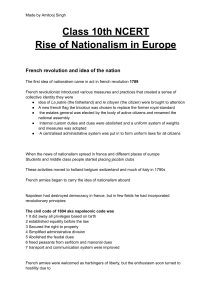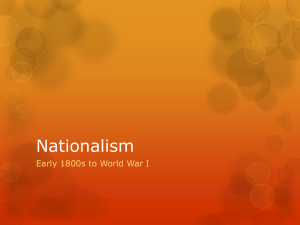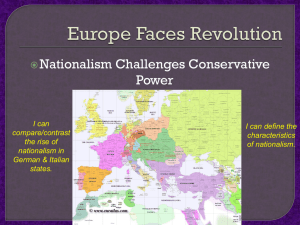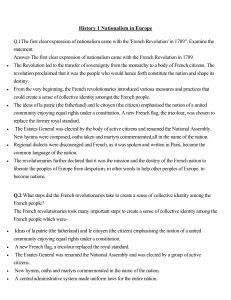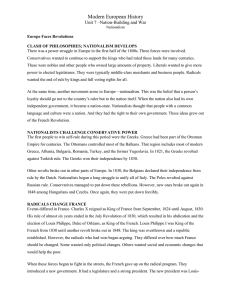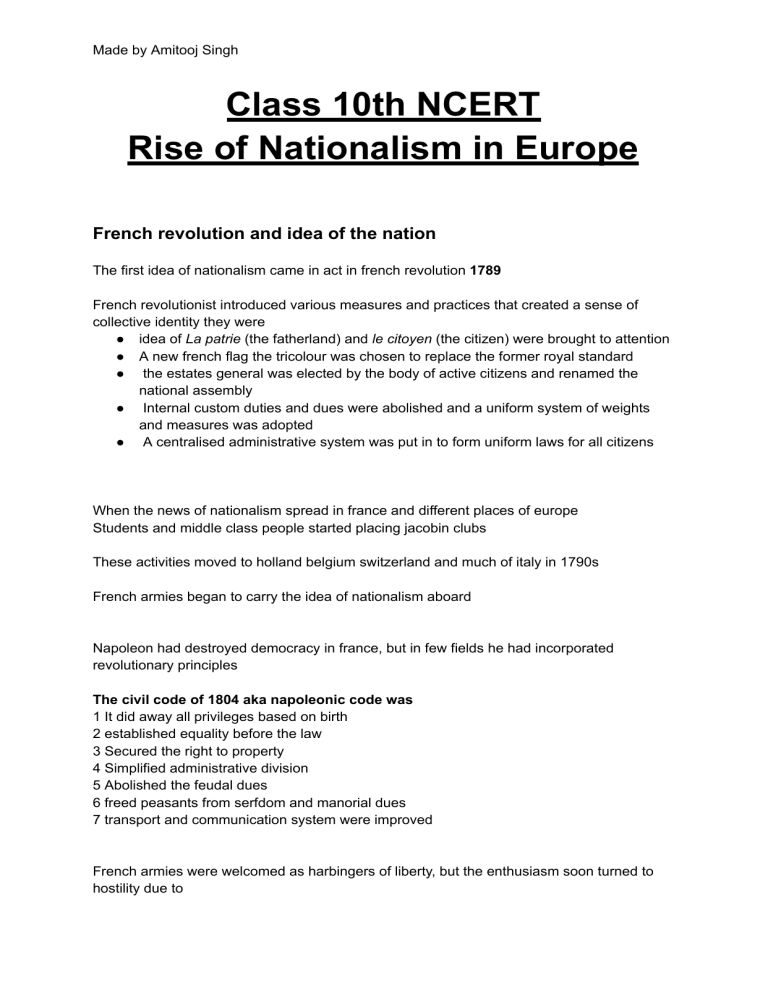
Made by Amitooj Singh Class 10th NCERT Rise of Nationalism in Europe French revolution and idea of the nation The first idea of nationalism came in act in french revolution 1789 French revolutionist introduced various measures and practices that created a sense of collective identity they were ● idea of La patrie (the fatherland) and le citoyen (the citizen) were brought to attention ● A new french flag the tricolour was chosen to replace the former royal standard ● the estates general was elected by the body of active citizens and renamed the national assembly ● Internal custom duties and dues were abolished and a uniform system of weights and measures was adopted ● A centralised administrative system was put in to form uniform laws for all citizens When the news of nationalism spread in france and different places of europe Students and middle class people started placing jacobin clubs These activities moved to holland belgium switzerland and much of italy in 1790s French armies began to carry the idea of nationalism aboard Napoleon had destroyed democracy in france, but in few fields he had incorporated revolutionary principles The civil code of 1804 aka napoleonic code was 1 It did away all privileges based on birth 2 established equality before the law 3 Secured the right to property 4 Simplified administrative division 5 Abolished the feudal dues 6 freed peasants from serfdom and manorial dues 7 transport and communication system were improved French armies were welcomed as harbingers of liberty, but the enthusiasm soon turned to hostility due to Made by Amitooj Singh Increase taxation, censorship ,forced conscription The making of nationalism in europe The aristocracy and middle class Aristocracy was the dominant class. They owned estates in the countryside and they spoke french for diplomacy. Their family were often connected by ties of marriage. The majority of the population was made o the peasantry During Industrialisation, a new social group emerged, a working class and middle class made up of industrialist businessman pros They were small groups iin central europe and eastern eu. What did liberal nationalism stand for ? Liberalism derives from the latin root liber meaning free. For new middle class liberalism stood for freedom for the individual and equality before the law Politically it meant the concept of goverment by consent Yet it did not stand for universal suffrage The right to vote and get elected was granted exclusively to property owning men. Men without property and all women were excluded from political rights. Napoleon code went back to limited suffrage and reduced women to status of minor. In early 20th century women and non propertied men demanded for equal political power In economics liberalism stood for freedom of market and abolition of state imposed restrictions. There were 39 german states, each of them possessed its own currency and weighs and measures. Such conditions were viewed as obstacles to economic exchange In 1834, a custom union or zollverein was formed at the initiative of Prussia and joined most of the German states. This union abolished tariff barriers and reduced the number of currencies from 30 to 2 A new conservatism after 1815 After Napoleon was defeated. European governments were driven by a sprit of conservatism.They believed that the established traditional institutions of state and society like the monarch, the church. Social hierarchies ,property and family should be preserved They realised that modernisation could strengthen traditional institution like the monarchy Made by Amitooj Singh A modern army, an efficient bureaucracy, a dynamic economy, the abolition of feudalism and serfdom could strengthened the autocracy monarchies Treaty of Vienna 1815 On 1815 - britain russia prussia and austria who had defeated napoleon met in vienna to draw up settlement for europe. Hosted by Duke Metternich The effects of this treaty were 1 The bourbon dynasty was restored to power. 2 France lost its territories acquired during napoleon rule to prevent expansion of france 3 39 German confederation were let untouched Conservatives did not tolerate criticism and dissent and sought to curb activities that questioned the legitimacy of autocratic government. Newspaper book plays and songs that expressed nationalism and liberalism The Revolutionaries In 1815 the fear of repression drove to many secret societies.Most of these revolutionaries also saw the creation of nation states as necessary part of this struggle for freedom Giuseppe Mazzini born in genoa in 1807. He Founded young italy in marseilles and young europe in berne These socity’s member were like minded young men from poland france italy and the german states The age of revolutions 1830-1848 As Conservative activities grew, liberalism spread. JULY REVOLUTION First upheaval took place in France july 1830. Bourbon king was overthrown by liberal revolutionaries who installed a constitutional monarchy with louis philippe at its head July revolution sparked an uprising in brussels which led to belgium breaking away from Netherlands Greece had been part of ottoman empire since fifteenth century. The growth of revolutionary nationalism in europe sparked off struggle in greece for independence Greece got support from other Greeks living in exile and also from many west europeans The english port lord byron organised funds and later went to fight in war where he died of fever in 1824 The Treaty of constantinople 1832 made greece an independent nation The romantic imagination and national feeling Made by Amitooj Singh 1. Culture played an important role in creating the idea of the nation: art and poetry, stories and music helped express and shape nationalist feelings. 2. Romanticism, a cultural movement which sought to develop a particular form of nationalist sentiment. Language also played an important role in developing nationalist sentiments. 3. Russian language was imposed everywhere and in 1831 an armed rebellion against Russian rule took place which was ultimately crushed. Hunger, Hardship and Popular revolt The 1830 were years of great economic hardship in europe. In most countries there were more seekers of jobs than employment. the aristocracy still enjoyed power, peasants struggled under the burden of feudal dues and obligations. r. Food shortages and widespread unemployment brought the population of Paris out on the roads. 1848 The revolution of liberals men and women of the liberal middle classes combined their demands for constitutionalism with national unification. They took advantage of the growing popular unrest to push their demands for the creation of a nation-state on parliamentary principles – a constitution, freedom of the press and freedom of association On 1848 831 elected representatives marched in a festive procession to take their places in frankfurt parliament They drafted a constitution for a German nation to be headed by a monarchy subject to a parliament Crown was offered to Friedrich Wilhelm IV, King of Prussia, he rejected it and joined other monarchs to oppose the elected assembly. parliament was dominated by the middle classes who resisted the demands of workers and artisans and consequently lost their support. In the end troops were called in and the assembly was forced to disband The issue of extending political rights to women was a controversial.Women had formed their own political associations, founded newspapers and taken part in political meetings and demonstrations. They were still denied Convervatives were able to suppress liberal movement. , they could not restore the old order They began to realise that the cycles of revolution and repression could only be ended by granting concessions to the liberal-nationalist revolutionaries. So in Central and eastern europe serfdom and bonded labour were abolished both in the Habsburg dominions and in Russia. The Habsburg rulers granted more autonomy to the Hungarians in 1867 Made by Amitooj Singh The making of Italy and Germany Nationalist sentiments were often mobilised by conservatives for promoting state power and achieving political domination over Europe. Germany Germans, who in 1848 tried to unite the different regions of the German confederation into a nation-state governed by an elected parliament. This movement was repressed by the combined forces of the monarchy and the military, supported by the large landowners (called Junkers) of Prussia. After this Prussia took on the leadership of the movement for national unification. Otto von Bismarck, was the architect of this process with the help of the Prussian army and bureaucracy Three wars over seven years – with Austria, Denmark and France – ended in Prussian victory and completed the process of unification. In January 1871, the Prussian king, William I, was proclaimed German Emperor in a ceremony held at Versailles. The new state placed a strong emphasis on modernising the currency, banking, legal and judicial systems in Germany. Prussian measures and practices often became a model for the rest of Germany Italy , Italy was divided into seven states, of which only one, Sardinia-Piedmont, was ruled by an Italian princely house. The north was under Austrian Habsburgs, the centre was ruled by the Pope and the southern regions were under the domination of the Bourbon kings of Spain During 1830s Giuseppe Mazzini had sought to put together a coherent programme for a unitary Italian Republic. The failure of revolutionary uprisings both in 1831 and 1848 meant that the mantle now fell on Sardinia-Piedmont under its ruler King Victor Emmanuel II Chief Minister Cavour who led the movement to unify the regions of italy. Through h a tactful diplomatic alliance with France engineered by Cavour. Sardinia-Piedmont succeeded in defeating the Austrian forces in 1859. a large number of armed volunteers under the leadership of Giuseppe Garibaldi joined the fray. they marched into South Italy and the Kingdom of the Two Sicilies and succeeded in winning the support of the local peasants In 1861 Victor Emmanuel II was proclaimed king of united Italy However illiteracy were very high, remained blissfully unaware of liberalnationalist ideology The peasant masses who had supported Garibaldi in southern Italy had never heard of Italia, and believed that ‘La Talia’ was Victor Emmanuel’s wife! Made by Amitooj Singh Britain In Britain the formation of the nation-state was not the result of a sudden upheaval or revolution. There was no British nation prior to the eighteenth century The identity of people who inhabited the british were english welsh scottish and irish. English nation steadily grew in wealth, importance and power, it was able to extend its influence over the other nations of the islands. . The Act of Union (1707) between England and Scotland that resulted in the formation of the ‘United Kingdom of Great Britain. The british parliament was dominated with english members. Due to this scotland culture and political institution were suppressed. The Scottish Highlanders were forbidden to speak their Gaelic language or wear their national dress, and large numbers were forcibly driven out of their homeland Ireland was deeply divided between Catholics and Protestants.. The English helped the Protestant. Catholic revolts against British dominance were suppressed. Ireland was forcibly incorporated into the United Kingdom in 1801. British anthem and flag were promoted and older nation were subordinate to this union Visualising the nation Nations were then portrayed as female figures. The female form that was chosen to personify the nation did not stand for any particular woman in real life;the female figure became an allegory of the nation. Marianne Her characteristics were drawn from those of Liberty and the Republic – the red cap, the tricolour, the cockade Germania In visual representations, Germania wears a crown of oak leaves, as the German oak stands for heroism
